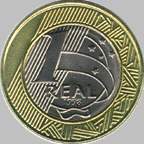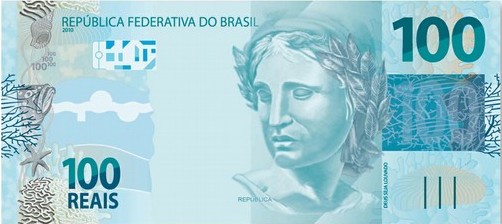|


The real (pronounced /reÍäl/ in English) is the present-day currency of Brazil. Its sign is R$ and its ISO code is BRL. It is subdivided into 100 centavos ("hundredths"). In Brazil, the decimal separator is a comma, and a period may be used as thousands separator, as in "R$ 123.456,78".
The modern real was introduced in 1994 as part of the Plano Real, a substantial monetary reform package that aimed to put an end to three decades of rampant inflation. At the time it was meant to have approximately fixed 1:1 exchange rate with the United States dollar. It suffered a sudden devaluation to a rate of about 2:1 in 1999, reached almost 4:1 in 2002, then partly recovered and has been approximately 2:1 since 2006. The exchange rate as of June 18, 2010 is approximately BRL 1.77 to USD 1.00.
The first official currency of Brazil from 1690 to 1942 was also called real (plural reis, sign Rs$).
In Portuguese the word real means both "royal" and "real". The name of the historic real derived from the first sense. The name of the modern currency is generally understood to refer both to the historic unit and to the second sense.
The dollar-like sign in the currency's symbol (both historic and modern), and in all the other past Brazilian currencies, is officially written with two vertical strokes () rather than one. However Unicode considers the difference to be only a matter of font design, and does not have a separate code for the two-stroked version.
HISTORY
The modern real (plural reais) was introduced on July 1, 1994, during the presidency of Itamar Franco, when Fernando Henrique Cardoso was the Minister of Finance, as part of a broader plan to stabilize the Brazilian economy, known as the Plano Real. The new currency replaced the short-lived cruzeiro real (CR$). The reform included the demonetization of the cruzeiro real and required a massive banknote replacement.
At its introduction, the real was defined to be equal to 1 unidade real de valor (URV, "real value unit") a non-circulating currency unit. At the same time the URV was defined to be worth 2750 cruzeiros reais, which was the average exchange rate of the U.S. dollar to the cruzeiro real on that day. As a consequence, the real was worth exactly one US dollar as it was introduced. Combined with all previous currency changes in the country's history, this reform made the new real equal to 2.75 x 1018 (2.75 quintillion) of Brazil's first currency, which was also called "real".
Soon after its introduction, the real unexpectedly gained value against the U.S. dollar, due to large capital inflows in late 1994 and 1995. During that period it attained its maximum dollar value ever, about US$ 1.20. Between 1996 and 1998 the exchange rate was tightly controlled by the Central Bank, so that the real depreciated slowly and smoothly in relation to the dollar, rising from near 1:1 to about 1.2:1 by the end of 1998. In January 1999 the Central Bank, under its new president Arminio Fraga, released its control. The Real suffered sudden and unexpected maxi-devaluation, to a rate of almost R$2 : US$1.
In the following years, the currency's value against the dollar followed an erratic but mostly downwards path from 1999 until late 2002, when the prospect of the election of leftist candidate Luiz Inacio Lula da Silva, considered a radical populist by sectors of the financial markets, prompted another currency crisis and a spike in inflation. Many Brazilians feared another default on government debts or a resumption of heterodox economic policies, and rushed to exchange their reais into tangible assets or foreign currencies. In October 2002 the exchange rate reached its historic low of almost R$4 per US$1. The crisis subsided once Lula took office, after he, his finance minister Antonio Palocci, and Arminio Fraga reaffirmed their intention to continue the orthodox macroeconomic policies of his predecessor (including inflation-targeting, primary fiscal surplus and floating exchange rate, as well as continued payments of the public debt). The value of the real in dollars continued to fluctuate but generally upwards, so that by 2005 the exchange was a little over R$2 : US$1. In May 2007, for the first time since 1999, the real became worth more than US$ 0.50 - even though the Central Bank, concerned about its effect on the Brazilian economy, had tried to keep it below that symbolic threshold.
As of June 22, 2010, 1 Brazilian real is valued at 0.5612 US dollars; in other words, while 1 U.S. dollar is worth 1.7820 Brazilian real.
COINS
First series (1994-2003)
In 1994, coins were introduced in denominations of 1, 5, 10, 25 and 50 cents and 1 real. All were struck in stainless steel. They remain legal tender but since December 23, 2003 they are being withdrawn from circulation by the Central Bank.
Second series (1998-)
In 1998, a second series of coins was introduced. It featured copper-plated steel coins of 1 and 5 centavos, brass-plated steel coins of 10 and 25 centavos, a cupronickel 50 centavos coin, and a bi-coloured brass and cupronickel coin of 1 real.
From 2002 onwards, steel was used for the 50 centavos coin the central part of the 1 real coin.
In November 2005, the Central Bank discontinued the production of 1 centavo coins, but the existing ones continue to be legal tender. Retailers now generally round their prices to the next 5 or 10 centavos.
Commemorative coins
The Brazilian Central Bank has also issued special commemorative versions of the 1 real coin on special occasions. These coins are legal tender and differ from the standard ones only on the reverse side.
BANKNOTES
Original series
In 1994, banknotes were introduced in denominations of 1, 5, 10, 50 and 100 reais. These were followed by 2 reais in 2001 and 20 reais in 2002. In January, 2006, BCB discontinued the production of the 1 real banknote, but it remains legal tender.
Polymer 10 real note
In April 2000, in commemoration of the 500th anniversary of the Portuguese arrival on Brazilian shores, the Brazilian Central Bank released a polymer 10 real banknote that circulates along with the other banknotes above. The Brazilian Mint printed 250 million of these notes, which at the time accounted for about half of the 10 real banknotes in circulation.
This note contains a more complex design, as follows:Obverse:
- Image of Pedro Alvares Cabral, the Portuguese sea captain;
- A representation of the map "Terra Brasilis", one of the earliest drawings of the land;
- A passage from Pero Vaz de Caminha's letter to King Manuel I of Portugal, the first known description of Brazil;
- A 16th century Portuguese Rose of Winds;
- To the right of the map, five ships from Cabral's expedition appear;
- In the background, decorative elements from Portuguese tiles can be seen;
- The white area around the red dot is actually transparent (the red dot is translucent);
- Finally, also in the background, the Cross from the Order of Christ, which was present in all Portuguese ships of the time, appears.
Reverse: A styled version of a map of Brazil with photographs depicting the ethnic variety of the Brazilian people (white, black, amerindian).
New series
On February 3, 2010, the Central Bank of Brazil announced a new series of the real banknotes which would begin to be released in April 2010. The new design will add security enhancements to avoid counterfeiting. The notes will have different sizes according to their values to help vision-impaired people. The changes were made reflecting the growth of the Brazilian economy and the need for a stronger and safer currency. The new banknotes will be gradually implemented through 2012, coexisting with the older ones.
The text on this page has been made available under the Creative Commons Attribution-ShareAlike License and Creative Commons Licenses
|
